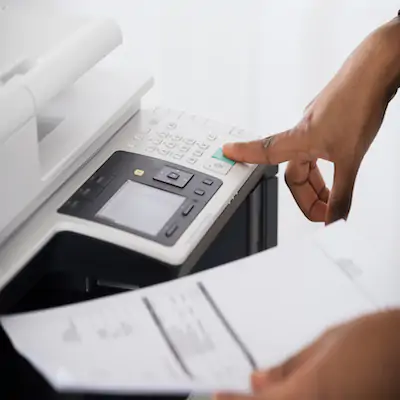
This article was originally published on Constructionexec.com
Print in Construction
Construction executives are well aware of the declining use of print for managing documents and information in the office and on the jobsite, but for many large contractors, expenditures related to printing are among their highest overhead costs.
These costs may go unnoticed, buried in corporate silos and beneath assumptions about how much companies actually pay for printers, supplies and maintenance. The supposition is that if a company is printing less today than a year ago, costs of printing should be declining.
Buying the lowest-cost printers and toner won’t solve the problem. Purchasing printing equipment might look like a win on the balance sheet, but when operating costs of office printing are considered in their entirety, the profit and loss statement almost always takes a hit.
A simple cost-benefit analysis on a printer rarely takes into account its ongoing use once it’s installed in an office. What is the price differentiation between color and black-and-white prints on a multi-function device, or large vs. small format documents? How much space do printers, supplies and the documents they produce take? How much time do administrative and IT staff spend changing toner cartridges or clearing paper jams?
On the other hand, what are the costs of not printing? Creating and using digital documents means more than saving all documents to PDF. While less expensive than print, there are still expenses and questions. Where are documents saved? How are they found? What kind of version control is required? Who has permission to see the documents? How are they distributed to the people who need them? How are they backed up? Who will train employees?
The digital infrastructure needed to manage, organize, distribute and find digital documents differs significantly from that used to manage paper documents. In addition to computer hardware, software and network design, creating a paperless environment—or simply reducing the amount of paper used in a business—requires constant attention along with effort, experience and expertise to get it right.
The question for managers is whether they want to take on the challenge themselves, especially when there are providers that supply print as a service. Aren’t there better things the procurement department could be doing to add value to the enterprise?
When contractors are presented with a service-level agreement that keeps printing capabilities and costs the same or better than current conditions, most prefer to avoid the hassles of selecting specific equipment and features via an RFP.
It’s easy to see why. Printing equipment is becoming a commodity in construction. Today’s printers are generally well-made, produce a great quality print and offer similar features. Major manufacturers are constantly improving reliability, adding sophisticated technical resources, providing easier and more secure networking and producing a lower cost per copy.
The distinguishing factor in office printing isn’t so much about the box anymore; it’s about the service.
Managers need more uptime, shorter lines at printers, easy-to-use and responsive help desks and middleware that helps managers see where they can save. They need help training users to be more efficient in their use of documents whether they print them or keep them digital. They need support implementing new equipment or features, and optimizing printer fleets over time. They need services that make them more productive, more focused on their core business and more efficient.
Those advantages don’t come with a printer, but they do come with an experienced service provider.
If the goal is to reduce the use of paper, aggressively manage printing costs, and increase efficiency and environmental accountability by using more digital documents, why buy printers? Digital documents are poised to replace paper documents in the next five years. Be ready with print as a service.